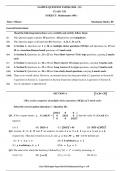Exam (elaborations)
not possible to complete (i) This Question paper contains 38 questions. All questions are compulsory. (ii) This Question paper is divided into five Sections - A, B, C, D and E. (iii) In Section A, Questions no. 1 to 18 are multiple choice questions (MCQs)
- Course
- Institution
(i) This Question paper contains 38 questions. All questions are compulsory. (ii) This Question paper is divided into five Sections - A, B, C, D and E. (iii) In Section A, Questions no. 1 to 18 are multiple choice questions (MCQs) and Questions no. 19 and 20 are Assertion-Reason based questions ...
[Show more]



